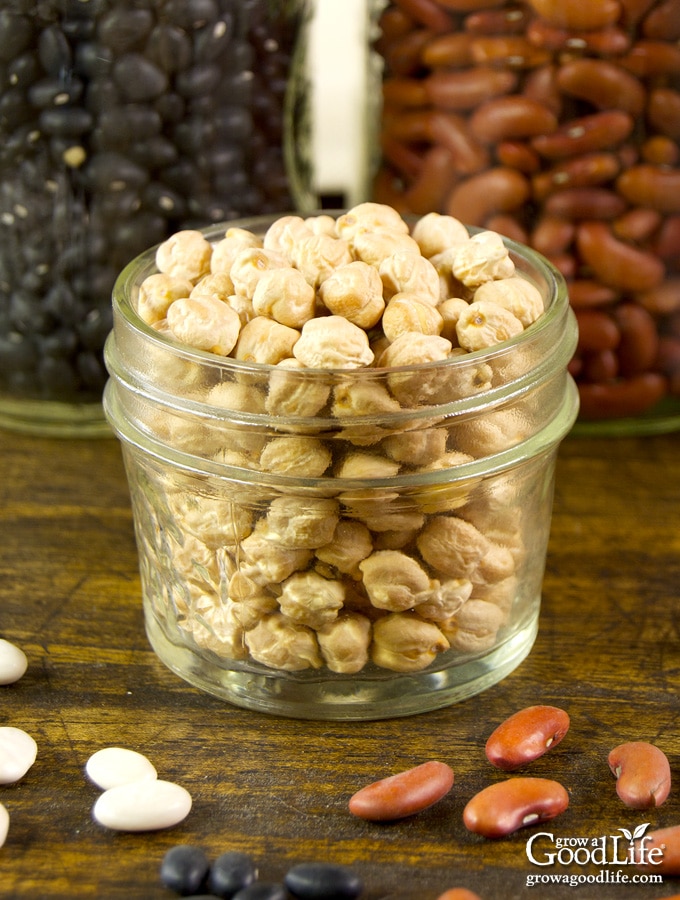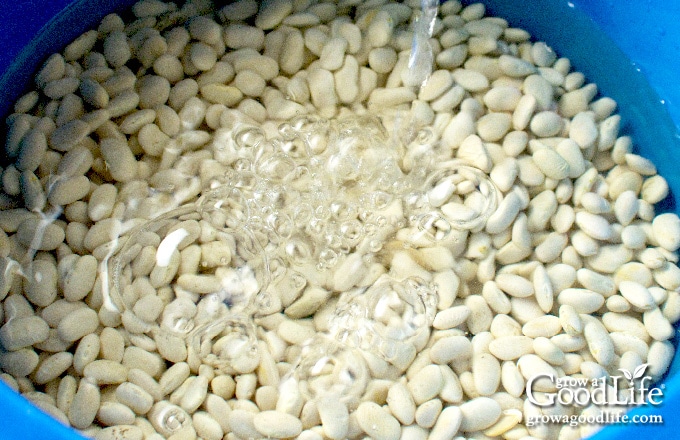3 Ways to Cook Dried Beans from Scratch
This post may contain affiliate links, which means that I may receive a commission if you make a purchase using these links. As an Amazon Associate I earn from qualifying purchases.
Cook dried beans from scratch and stop worrying about the extra sodium, safety of the chemicals lining the cans, and the metallic taste of canned beans. Cooking dried beans and freezing them will make it easy to add more beans to your everyday meals.

Beans are a budget-friendly source of fiber, protein, iron, vitamin B and C, and calcium. They can easily be used for making chili, simmered into New England Baked Beans, pureed into dips, and tossed into salads and salsas.
When it comes to purchasing beans, your choices are canned or dried. Canned beans are convenient, but there are many advantages to cooking dried beans from scratch.
Canned Beans vs. Cooking Dried Beans
Are dried beans worth the time and effort?
Here are some reasons you may want to cook dried beans from scratch instead of using canned beans:
- Better Flavor: Store bought canned beans doesn’t compare with the flavor you get from cooking dried beans from scratch. Fresh beans have a creamy texture while canned beans can be mushy. Plus additives in the canned beans and the can itself can alter the flavor of the beans.
- Costs Less: According to The Bean Institute, dry beans cost about one-third the price of canned beans purchased in the grocery store. A one-pound bag of dry beans will yield about 5-7 cups of cooked beans. That means a one-pound bag costs the same as about 3-4 cans.
- Less Sodium: NutritionFacts states that canned beans contain almost 100 times more sodium than dried beans. Draining and rinsing the canned beans reduces the sodium, but you are also draining away lots of flavor.
- No BPAs: Then there is always the issue of the chemicals in lining of the cans and that metallic taste.
- More Variety: You will find a greater variety of dried beans available than canned, allowing you to explore different sizes, textures, and flavors in your recipes.
Consider cooking dried beans from scratch and stop worrying about the extra sodium, safety of the chemicals lining the cans, and the metallic taste of canned beans.
Tips for Cooking Dried Beans from Scratch
The effort it takes to cook dried beans from scratch is minimal. It does take time to soak and cook the beans, but there is not a lot of actual hands-on time.
Thawing a container of beans is just as easy as opening a can. If you cook large batches of beans ahead of time, you can have a freezer full of a variety of beans ready to add to your favorite recipes.
Soaking the Dried Beans
There are many articles on the internet about skipping the soaking step when preparing dried beans, but soaking is recommended for many reasons:
- Increases Digestibility: Soaking softens the outer coating of the beans. This helps the beans absorb water and release starches that can cause gas and bloating.
- Removes Contaminants: Soaking the beans and rinsing removes dust and residue.
- Reduces Phytic Acids: Phytic acid can prevent the absorption of minerals like iron, zinc, and calcium. Soaking beans may decrease the effects of phytic acid on mineral absorption.
- Rehydrates the Beans: Soaking also rehydrates the beans, so they will soften properly when cooked.
Two Ways to Soak Dried Beans
Here are two ways you can soak your beans: Presoak overnight or quick soak:
- Soak Beans Overnight: Sort through the dry beans and pick out damaged beans and stones. Rinse the beans well and place them in a large pot. Add enough water to cover about 2-inches above the dried beans. Cover the pot and soak the beans in a cool area for at least 12-hours or overnight. Go ahead and place the pot into the refrigerator if the weather is warm.
- Quick Soak Dried Beans: If you are pressed for time, you can use the quick soak method. Bring a large pot of water to boil over high heat. Add dried beans and boil for 2 minutes. Remove the pot from the heat and let the beans soak for 1 hour.


Tips for Cooking Dried Beans in a Slow Cooker
Don’t skip the boiling for 10-minutes step before adding to your slow cooker. Slow cookers do not reach a high enough temperature to release a naturally-occurring toxin called, Phytohaemagglutinin. This toxin can cause gastroenteritis and make you sick.
Red kidney beans contain a high level of this toxin. To release this toxin and make kidney beans safe to consume, the FDA recommends soaking the beans for at least 5 hours, draining, rinsing, and boiling in fresh water at 212˚F (100˚C) for 10 minutes before adding to your slow cooker. Other dried beans contain this toxin as well, but in smaller doses. Boil your dried beans for 10 minutes before adding to your slow cooker.
Tips for Cooking Dried Beans Using Electric Pressure Cookers
Electric pressure cookers are a huge time saver in the kitchen. Since pressure cookers cook dried beans quickly the timing is slightly different depending on the type of bean.
The Instant Pot seems to be the most common brand and is the one used for this recipe.
Instant Pot recommends the following average cooking times for pre-soaked dried beans:
- 8 minutes for black beans, cannellini beans, great northern beans, kidney beans, navy beans, pinto beans, and scarlet runner beans.
- 13 minutes for chickpeas and lima beans.
- Check your users manual for instructions for cooking dried beans in your electric pressure cooker. The timing may be different depending on the brand.
It is also recommended to add 1 tablespoon of extra virgin olive oil or avocado oil to prevent foaming, which can clog the vent.
Allow the pressure release naturally. Letting the pressure release slowly seems to reduce the amount of broken beans.
When the beans are finished cooking, they are ready to use in your favorite recipes. The bean cooking liquid is filled with flavor. Substitute bean cooking liquid for water in your recipes.
3 Ways to Cook Dried Beans from Scratch
Ingredients
- 1 pound dried beans
- water
Instructions
Presoak the Beans (for all cooking methods):
- Sort through the dry beans and pick out stones and damaged beans. Rinse the beans well and place them in a large pot.
- Add enough cold water to cover the dried beans about 2-inches, about 6 cups. Cover and soak the beans at least 12-hours or overnight.
- After the beans have finished soaking, drain and rinse well.
Cooking Dried Beans on the Stove:
- Add the soaked beans to a large pot. Fill with fresh water to cover the beans 2-inches, about 6 cups.
- Cover the pot and bring to a boil over medium-high heat for 10 minutes. Reduce the heat to low and simmer. Stir the beans occasionally to prevent sticking.
- Cook the beans for one hour, and then begin checking to see if they are tender. Continue cooking until beans are done. Stir occasionally and test every 15 minutes.
- Add additional water if needed to keep the beans immersed. Depending on the size, variety, and age, dried beans can take 1-3 hours to cook.
Cooking Dried Beans in a Slow Cooker
- Add the soaked beans to a large pot. Fill with fresh water to cover the beans 2-inches, about 6 cups. Bring the pot to a boil over high heat, precook for 10 minutes, and drain.
- Add the precooked beans to the slow cooker crock. Fill with fresh water to cover the beans 2-inches, about 6 cups.
- Cover the slow cooker and cook on low for 8 hours.
- After 8 hours, begin checking to see if the beans are tender. Continue cooking until beans are soft. Stir occasionally and test every 15 minutes until done.
- Depending on the size, variety, and age, dried beans can take 8-12 hours to cook in a slow cooker.
Cooking Dried Beans in an Instant Pot
- Add the soaked beans and 1 tablespoon of extra virgin olive oil to the pressure cooker. Fill with fresh water to cover the beans 2-inches, about 6-8 cups (do not fill the pressure cooker more than half full).
- Secure the lid and turn the regulator valve to “sealing” position.
- Cook the dried beans. Instant Pot recommends the following average cooking times for pre-soaked dried beans: 8 minutes for black beans, cannellini beans, great northern beans, kidney beans, navy beans, pinto beans, and scarlet runner beans. 13 minutes for chickpeas and lima beans. Check your users manual for instructions for cooking dried beans in your pressure cooker. The timing may be different using other brands.
- Let the pressure release naturally.
- If beans are not done, place the lid back on the pressure cooker, turn the regulator valve to “sealing” position, and cook at high pressure for another 5-10 minutes. Let the pressure release naturally.
Notes
Nutrition
To Store Cooked Beans: Turn off the heat and let the beans cool. Divide the beans and cooking liquid into pint sized storage containers. About 1 1/2 cups of cooked beans plus 1/2 cup of cooking liquid is equivalent to one can of beans. Label your containers and store in the fridge for about a week, or freeze for up to a year. Thaw the beans before adding to recipes.
References and Further Reading:
- Nutritional Benefit of Soaking Beans Prior to Cooking
- BPA Replacement Also Alters Hormones
- Phytohaemagglutinin (kidney bean lectin)
You May Also Like:
- Slow Cooker New England Baked Beans
- Roasted Garlic White Bean Dip
- Crockpot White Bean Chicken Chili
- Easy Slow cooker Chili Recipe
- How to Can Dried Beans
10 Cookie Mix in a Jar Recipes eBook
Homemade gifts are always appreciated because they come from the heart. Even if you are not crafty, you can give DIY gifts to your family and friends with these easy recipes for making cookie mix in a reusable jar.



Why do you add olive oil?
Instant Pot and other pressure cooker manufacturers recommend using olive oil to prevent foaming, which can clog the vent.
Great tips! Beans can be tricky.